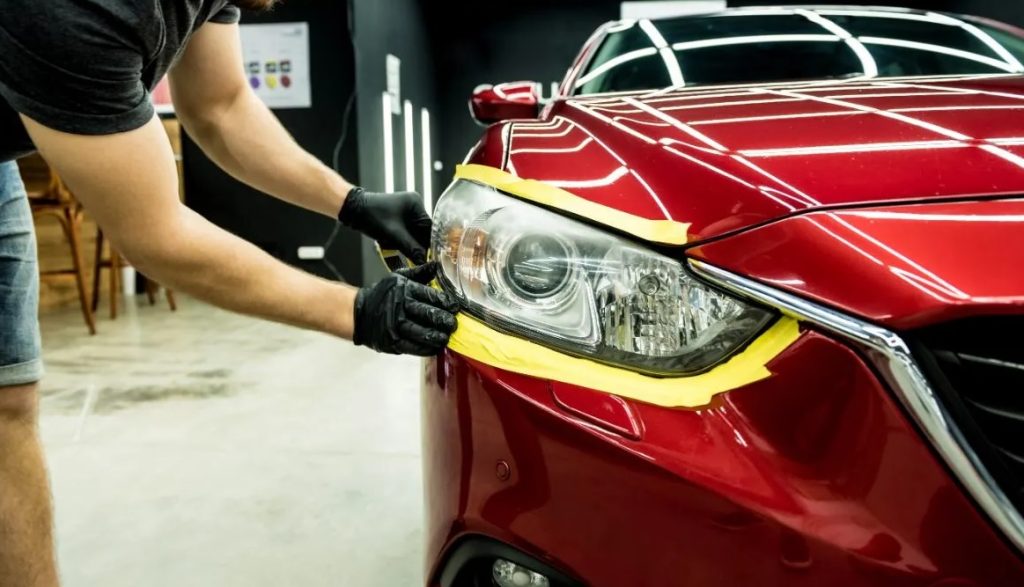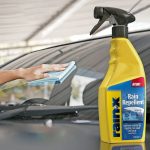Duct tape, that trusty go-to for quick fixes around the house, often finds itself enlisted in various DIY automotive repairs. But beneath its seemingly universal utility lies a question of potential concern: Could duct tape be causing unintended damage to your car’s precious paint job? In this detailed exploration, we’ll embark on a comprehensive journey through the intricacies of duct tape use in automotive scenarios, shedding light on both the myths and the realities. Let’s separate fact from fiction and arm you with the knowledge needed to navigate the world of duct tape without compromising your car’s aesthetic appeal.
Understanding the Concerns
1. The Myth of Harmless Duct Tape
Duct tape’s reputation as a universal problem solver often leads car owners to believe it’s entirely benign. However, it’s crucial to grasp the nuances of its composition and adhesive nature to understand why exercising caution is paramount.
Duct tape comprises a fabric backing coated with a strong adhesive, making it exceptionally sticky and resilient. While this makes it effective for a myriad of tasks, it also raises questions about its compatibility with delicate car paint.
2. Adhesive Residue Woes
One of the primary concerns associated with duct tape is the adhesive residue it leaves behind. The sticky remnants can linger on your car’s surface, potentially leading to unsightly blemishes and, if left unattended, long-term damage.
Understanding the composition of the adhesive is key. Some duct tapes use stronger adhesives that may bond aggressively with the paint, making residue removal more challenging. We’ll delve into effective methods for safely removing these residues later in the article.
3. Paint Compatibility Matters
Car paints come in various formulations, and not all are created equal. Certain types of paint may be more susceptible to damage from the adhesive in duct tape. It’s crucial to identify the paint type on your vehicle and tailor your approach accordingly.
Differentiating between water-based and solvent-based paints, for instance, can significantly impact how your car reacts to duct tape. We’ll explore the science behind these reactions and offer guidance on protecting your specific paint type.
Real Risks or Overblown Fears?
4. Abrasion and Scratching
While duct tape is often used for temporary fixes like holding a loose bumper in place, concerns arise regarding the potential for abrasions and scratches during application and removal. We’ll dissect the likelihood of these risks and provide insights into minimizing any potential damage.
Understanding the variables at play, such as the condition of your car’s paint and the quality of the duct tape used, is crucial for accurate risk assessment. We’ll guide you through best practices to mitigate these concerns.
5. Chemical Reactions Unveiled
Beyond physical abrasions, there’s a concern about chemical reactions between the adhesive in duct tape and the components of car paint. We’ll unravel the science behind these reactions, exploring whether they pose a legitimate threat to your car’s finish.
By understanding the chemical makeup of both duct tape adhesive and car paint, you’ll be better equipped to make informed decisions about whether and how to use duct tape for your automotive needs.
Safeguarding Your Car’s Finish
6. Choosing the Right Tape
Not all duct tapes are created equal. In this section, we’ll delve into the world of duct tape varieties, highlighting those with less aggressive adhesives and a lower likelihood of causing damage to your car’s paint.
From cloth-backed tapes to specialty automotive tapes, we’ll guide you in selecting the right tape for the task at hand, ensuring your DIY efforts are both effective and safe for your vehicle.
7. Proper Application Techniques
The devil is in the details when it comes to applying duct tape to your car’s surface. We’ll provide step-by-step guidance on proper application techniques to minimize the risk of damage and ensure a secure fit.
From surface preparation to removal methods, this section will serve as your go-to resource for making the most of duct tape without compromising your car’s aesthetic appeal. (See Also: Does Armor All Damage Leather? Unveiling the Truth About Leather Care)
8. Quick Fixes and Temporary Solutions
Sometimes, duct tape is the only immediate solution available. In this section, we’ll explore common car issues that may require a quick fix and provide practical solutions using duct tape.
From loose moldings to temporary fixes for minor body damage, you’ll gain insights into addressing everyday car problems without compromising your vehicle’s long-term appearance.
DIY Paint Protection Strategies
9. Waxing and Sealants
Beyond duct tape, we’ll explore the protective power of waxing and sealants. Regular maintenance with these products can add an extra layer of defense against potential damage, including that from duct tape.
Understanding the types of wax and sealants suitable for your car’s paint will empower you to create a protective barrier that enhances longevity and minimizes the impact of external factors.
10. Protective Films and Covers
Going beyond the basics, this section explores the world of protective films and covers designed to shield your car’s paint from various external factors. From harsh weather conditions to occasional duct tape use, discover additional layers of protection for your vehicle.
We’ll delve into the different types of films and covers available, helping you make an informed decision based on your specific needs and usage patterns.
When to Seek Professional Help
11. Removing Adhesive Residues
If you’ve encountered adhesive residues from duct tape, fear not. In this section, we’ll provide a toolkit of tips and tricks for safely removing these residues without compromising your car’s paint.
From gentle solvents to DIY concoctions, you’ll learn effective methods for restoring your car’s finish and eliminating the remnants of past duct tape applications.
12. Professional Repairs for Paint Damage
Despite our best efforts, there are instances where professional intervention is necessary. In this concluding section, we’ll explore the options available for repairing paint damage caused by duct tape or other DIY fixes.
Understanding the nuances of professional repairs, including costs, processes, and choosing a reliable service, will empower you to make informed decisions when seeking assistance.
Expert Tips: Safeguarding Your Car Paint from Duct Tape Dilemmas
When it comes to maintaining your car’s pristine paint job while using duct tape for quick fixes, expert tips can be invaluable. Let’s delve into a set of actionable strategies to help you navigate the delicate balance between DIY solutions and safeguarding your vehicle’s aesthetic appeal.
1. Choose the Right Tape Wisely
Not all duct tapes are created equal. Opt for automotive-grade tapes with less aggressive adhesives to minimize the risk of damage to your car’s paint. Specialty tapes designed for temporary fixes strike the right balance between stickiness and safety.
2. Clean and Prepare the Surface
Before applying duct tape, ensure the targeted surface is clean and dry. Remove any existing residues or contaminants to prevent them from interacting with the adhesive. A clean canvas not only improves tape adhesion but also reduces the likelihood of damage during removal. (See Also: How to Remove Painted Pinstripes from Car: A Step-by-Step Guide)
3. Apply with Precision
When applying duct tape, do so with precision. Avoid unnecessary stretching or pulling, as this can strain the adhesive and increase the risk of paint damage. Smooth out the tape carefully to ensure proper adhesion without compromising your car’s finish.
4. Limit Exposure Time
While duct tape is a temporary fix, leaving it on for extended periods can heighten the risk of adhesive residues bonding with the paint. Use duct tape for short-term solutions and prioritize permanent fixes to minimize prolonged exposure.
5. Test in an Inconspicuous Area
Before using duct tape on a visible part of your car, conduct a small-scale test in an inconspicuous area. This allows you to assess how the tape interacts with your specific paint type without risking damage to the prominent surfaces of your vehicle.
6. Invest in Quality Paint Protection Films
Consider applying quality paint protection films to vulnerable areas of your car. These transparent films act as an additional layer, shielding the paint from the potential impact of duct tape and other external factors.
7. Regular Waxing for Added Protection
Regularly waxing your car creates a protective barrier that minimizes the impact of adhesive residues. Choose a high-quality automotive wax and follow a consistent waxing schedule to enhance your car’s resilience against potential damage.
8. Use Adhesive Residue Removers Sparingly
When removing adhesive residues left by duct tape, opt for gentle adhesive residue removers. Use them sparingly and test in a small area first to ensure they effectively dissolve the residue without harming the underlying paint.
9. Monitor and Address Paint Damage Promptly
Stay vigilant and monitor your car’s paint for any signs of damage. If you notice scratches, abrasions, or discoloration, address the issue promptly. Swift action can prevent minor damage from escalating into more significant and costly repairs.
10. Consult Professionals for Complex Fixes
For complex paint damage or persistent issues, don’t hesitate to consult professionals. Experienced auto body shops and paint specialists have the expertise to assess and address paint damage effectively, ensuring your car looks its best for years to come.
By incorporating these expert tips into your approach, you can confidently use duct tape for temporary fixes without compromising your car’s paint. Remember, proactive measures and informed decisions are the keys to preserving the aesthetic appeal of your vehicle.
FAQs: Navigating the Duct Tape Dilemma for Car Paint
Navigating the realm of duct tape and its potential impact on your car’s paint can be a perplexing journey. To shed light on common concerns and provide clarity, we’ve compiled a set of frequently asked questions along with expert answers. Let’s unravel the mysteries surrounding duct tape and safeguarding your car’s aesthetic appeal.
1. Can Duct Tape Damage Car Paint?
Absolutely. While duct tape is a versatile solution, its adhesive nature can potentially damage car paint. Understanding the risks and adopting preventive measures is crucial for preserving your vehicle’s finish.
2. What Types of Duct Tape are Safer for Cars?
Opt for automotive-grade duct tapes with less aggressive adhesives. These tapes are designed for temporary fixes and pose a lower risk of damaging your car’s paint.
3. How Do I Remove Duct Tape Residue Without Harming the Paint?
Use gentle adhesive residue removers sparingly. Test in a small area first to ensure the remover effectively dissolves the residue without causing harm to the underlying paint.
4. Can I Leave Duct Tape on My Car for an Extended Period?
It’s not recommended. Duct tape is a temporary fix, and prolonged exposure can increase the risk of adhesive residues bonding with the paint. Use duct tape for short-term solutions. (See Also: What Does Rain-X Do for Your Car? Unveiling the Benefits of Rain-X Technology)
5. Are Certain Car Paints More Vulnerable to Duct Tape Damage?
Yes. Different car paints react differently to duct tape adhesive. Water-based and solvent-based paints, for example, may have varying susceptibility levels. Understanding your car’s paint type is crucial.
6. Is Waxing Effective in Protecting Against Duct Tape Residues?
Yes. Regular waxing creates a protective barrier that minimizes the impact of adhesive residues. Choose a high-quality automotive wax and follow a consistent waxing schedule.
7. Should I Test Duct Tape on a Small Area Before Applying?
Absolutely. Conduct a small-scale test in an inconspicuous area before applying duct tape to visible parts of your car. This helps assess how the tape interacts with your specific paint type.
8. Can Paint Protection Films Help Prevent Duct Tape Damage?
Yes. Applying quality paint protection films to vulnerable areas adds an extra layer of protection, shielding the paint from potential damage caused by duct tape and other external factors.
9. What Do I Do If Duct Tape Causes Noticeable Paint Damage?
Address the issue promptly. For complex paint damage or persistent issues, consult professionals. Auto body shops and paint specialists have the expertise to assess and address paint damage effectively.
10. How Can I Safely Apply Duct Tape Without Damaging the Paint?
Apply duct tape with precision. Avoid unnecessary stretching or pulling, and ensure the surface is clean and dry before application. Following proper techniques can help minimize the risk of damage.
By exploring these frequently asked questions and their answers, you’ll gain valuable insights into using duct tape for temporary fixes without compromising your car’s paint. Stay informed, take preventive measures, and enjoy a well-maintained vehicle for years to come.
Conclusion: Striking a Balance
In the world of DIY automotive care, balance is key. As we conclude this in-depth exploration, we emphasize the importance of knowledge in preserving your vehicle’s aesthetic appeal.
Armed with insights from this guide, you can confidently navigate the realm of duct tape without sacrificing your car’s impeccable paint finish. Remember, it’s not just about fixing issues; it’s about doing so in a way that preserves the integrity and longevity of your vehicle.
Stay informed, stay proactive, and keep your car shining!



